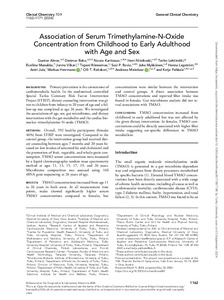Association of Serum Trimethylamine-N-Oxide Concentration from Childhood to Early Adulthood with Age and Sex
Almer, Gunter; Enko, Dietmar; Kartiosuo, Noora; Niinikoski, Harri; Lehtimäki, Terho; Munukka, Eveliina; Viikari, Jorma; Rönnemaa, Tapani; Rovio, Suvi P; Mykkänen, Juha; Lagström, Hanna; Jula, Antti; Herrmann, Markus; Raitakari, Olli T; Meinitzer, Andreas; Pahkala, Katja
https://urn.fi/URN:NBN:fi-fe2025082787840
Tiivistelmä
Background: Primary prevention is the cornerstone of cardiometabolic health. In the randomized, controlled Special Turku Coronary Risk Factor Intervention Project (STRIP), dietary counseling intervention was given to children from infancy to 20 years of age and a follow-up was completed at age 26 years. We investigated the associations of age, sex, gut microbiome, and dietary intervention with the gut metabolite and the cardiac biomarker trimethylamine-N-oxide (TMAO).
Methods: Overall, 592 healthy participants (females 46%) from STRIP were investigated. Compared to the control group, the intervention group had received dietary counseling between ages 7 months and 20 years focused on low intakes of saturated fat and cholesterol and the promotion of fruit, vegetable, and whole-grain consumption. TMAO serum concentrations were measured by a liquid chromatography-tandem mass spectrometry method at ages 11, 13, 15, 17, 19, and 26 years. Microbiome composition was assessed using 16S rRNA gene sequencing at 26 years of age.
Results: TMAO concentrations increased from age 11 to 26 years in both sexes. At all measurement time points, males showed significantly higher serum TMAO concentrations compared to females, but concentrations were similar between the intervention and control groups. A direct association between TMAO concentrations and reported fiber intake was found in females. Gut microbiome analysis did not reveal associations with TMAO.
Conclusions: TMAO concentration increased from childhood to early adulthood but was not affected by the given dietary intervention. In females, TMAO concentrations could be directly associated with higher fiber intake suggesting sex-specific differences in TMAO metabolism.
Kokoelmat
- Rinnakkaistallenteet [27094]
